Nail psoriasis is one of the most common skin diseases. Like other types of pathology, this form has a recurrent, non-chronic course of infection. The main symptoms of psoriasis damage to the nail plates are changes in the shape, loss of shine, the formation of spots on the board, and at the same time the complete separation of the nail.
With this form, the skin around the plaque also suffers. Premature and incorrect treatment can lead to complications such as severe deformities and complete loss of nails on the hands and feet.
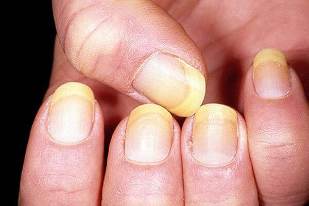
The treatment of psoriasis on the nail is similar to the treatment of other types, but has its own characteristics. In this article we will look at the symptoms, causes and treatment of nails and nails.
Nail damage in psoriasis can occur for a variety of reasons. Often this form is found in the background of a pathological form such as psoriatic arthritis.
In medical practice, this type is called nail psoriasis or psoriatic onychodystrophy. It is very rare, but often continues with complications and many undesirable symptoms.The following triggers can be attributed to the main causes of pathology:
- frequent stress and emotional stress;
- incorrect metabolic processes in the body;
- chronic infectious diseases;
- poor circulation;
- damage to nails and exposure to certain chemicals;
- genetic predisposition.
Important! In some patients, psoriasis of the nail occurs against the background of bacterial infection and damage to the nail plates. In such cases, it is very difficult to diagnose the disease; an experienced specialist should diagnose the disease.
Varieties
Psoriasis under the nails can develop in patients of different age groups, but most often occurs in patients over 35-40 years. There are several forms of the disease. These include:
High Syndrome
This type of board is characterized by the defeat in the form of point indentations. Often they are localized in a specific area of the nail, but it is often the case that the threads extend along the entire nail. Externally, the plaque resembles a ridge, which is why this type is often called a "ridge".
Onycholysis
This form has symptoms such as nausea and discoloration of the nail. This is due to the lack of healthy blood microcirculation. During the development of the disease, the plaque breaks down and disappears. Only a small part of the slab remains in the foundation.
The beginning of bleeding
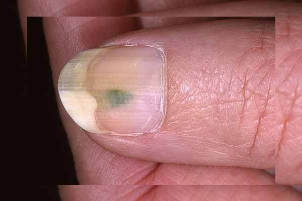
Indicates the formation of red or pink spots under the nails. These symptoms occur at the beginning of the pathology. In addition, symptoms such as the appearance of bruises under the plaque may occur. There is also compression and layering of the nail.
How is nail psoriasis or fungus different?
Patients often wonder how to differentiate nail fungus from psoriasis. This issue is very complicated and requires consultation with a specialist. Laboratory tests are also needed. Methods such as biopsy of dermis samples and histological examination help to remove the fungus.
Differential diagnosis can be used to rule out diseases that also affect the nails. These include the following diseases:
- lichen planus;
- various forms of dermatoses;
- eczema.
The main indicator of psoriasis is also the absence of abnormalities in the blood. An increase in the level of leukocytes and erythrocyte sedimentation rate often indicates the presence of infectious pathological forms.
Important! The difference between nail fungus and nail psoriasis can only be detected with the help of laboratory tests. Externally, the pathologies can be almost the same.
The main manifestations of the disease
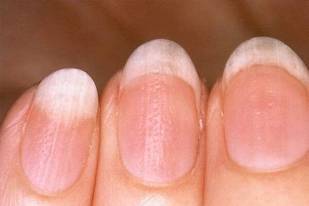
Psoriasis of the nails, like psoriasis of the nails, has very unpleasant symptoms. Below you can see photos of how psoriasis looks on the feet and nails. So, let's look at the manifestations of the disease, depending on its form.
Thimble psoriasis has the following symptoms:
- appearance of grooves, depressions in the form of dots;
- plaque nausea;
- From the outside, the plate bends and takes the form of a fork; Pain is noted when pressing
- .
Onycholysis:
- change the color of the board;
- nail violation, integrity violation;
- Detach the board from the body of the finger.
Bleeding:
- appearance of red, brown and cyanotic spots under the nail;
- plaque distortion, cloudiness;
- capillary damage; There may be a purulent discharge when
- is pressed.
Symptoms may vary slightly depending on the severity of the disease and the individual patient.
How to treat nail psoriasis
The question of how to treat nail psoriasis is very relevant today? There are many ways to treat the disease in modern medical practice. Key ones include:
- to use foreign products.
- Oral medication.
- Use of phototherapy and other physical therapies.
- Use of traditional medicine.
We then offer a closer look at each of the methods.
Treatment of psoriasis of the nails with creams and ointments
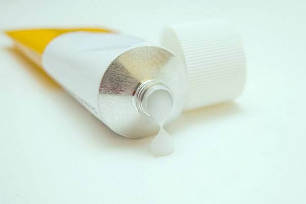
Psoriasis of the nails and early drug treatment involves the use of topical substances.
Ointments can be hormonal or non-hormonal. First, it is used for severe forms of the disease when non-hormonal drugs are ineffective.
Ointment for psoriasis of the nails on the hands and feet can also be non-hormonal. These include zinc, salicylic acid, etc. There are drugs.
Non-hormonal drugs have minimal side effects, are not addictive, but you have to wait a long time for the effect. Hormonal drugs have a rapid effect, but can cause many complications.
Oral medication use
Disease therapy should be comprehensive. The following remedies can also be used to relieve symptoms and restore nails:
- Sedatives.
- Immunomodulators. Medications help increase a person's natural defenses.
- Antiallergic drugs.
Physiotherapy
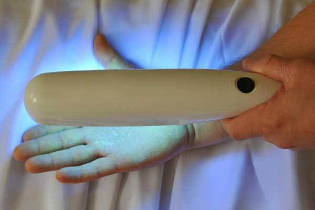
Recently, the use of physiotherapy methods has proven to be very good. The use of methods such as ultraviolet therapy, as well as cryotherapy, ozone therapy, excimer laser treatment gives excellent results. The following types of physical therapy are most commonly used in medical practice:
- UV radiation;
- PUVA therapy;
- x-ray therapy;
- use of ultrasound;
- laser treatment.
Important! The duration and number of sessions should be determined by an experienced specialist. Self-medication using these methods is strictly prohibited, as it often causes side effects.
The role of traditional medicine
Treatment of psoriasis with folk remedies has long been used as a full-fledged type of therapy. So, we will learn below how to treat psoriasis at home. There are many recipes that will help you cope with the pathological symptoms. The most popular drugs are:
Celandine decoction
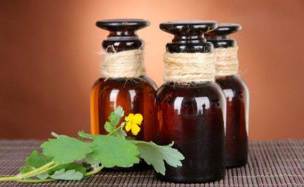
You need 2 tablespoons of 500 ml of water. l. horses. Boil the product on a low heat, cook for 30-40 minutes. The broth is used for bathing, dissolved in water in a ratio of 1: 2 and immersed in the nails for 20-25 minutes.
Treatment of psoriasis on nails with natural oils
Sea buckthorn oil eliminates inflammation very well. Softens affected areas, enriches nails with beneficial vitamins and minerals. To do this, using a cotton pad, apply the oil to the plates and leave for 30-40 minutes. The procedure is repeated 2-3 times a day.
Attention! If you decide to treat psoriasis on your own, consult a doctor beforehand, self-medication can damage your health!
Summer use
Fresh onions are passed through a meat grinder, the resulting gruel is applied to the affected nails. I put a gauze bandage on myself and leave for 30 minutes. The course of treatment continues until a healthy nail grows. Psoriasis of the nails is called a serious chronic disease. It is very important to diagnose the disease in time and start the necessary treatment. This will help keep your feet and hands healthy and prevent many unpleasant complications.
























